The “CAMINOS DE VENTIPPO” project, a reality since 2020, managed to materialize the signposting of two hiking routes, thus allowing the cohesion of two historical routes. Both routes, usually frequented by local residents, have been enhanced to spread the cultural identity and landscape heritage of Casariche.
The routes start from Cerro Belido, whose relevance derives from the extraction of building materials from Roman times, allowing us to discover the multiple olive trees that surrounds the town, the current town center, the scattered settlement of other areas, the river that feeds the municipality, as well as countless details that will attract the attention of the traveler. “Caminos de Ventippo” brings together everything that, in one way or another, has been and still is Casariche, giving a glimpse of the stories of the town that lay in the collective imagination of its inhabitants.
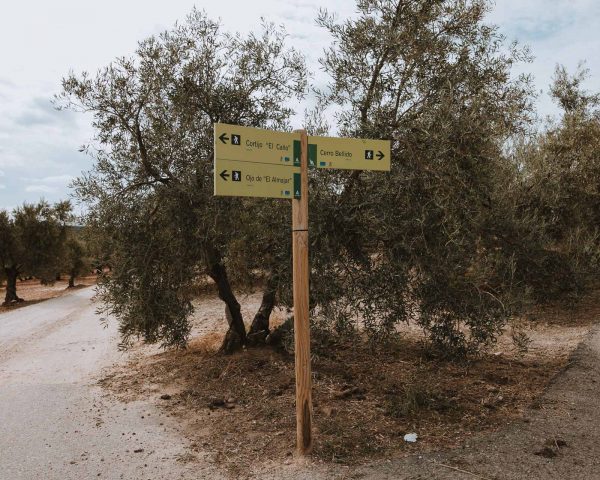
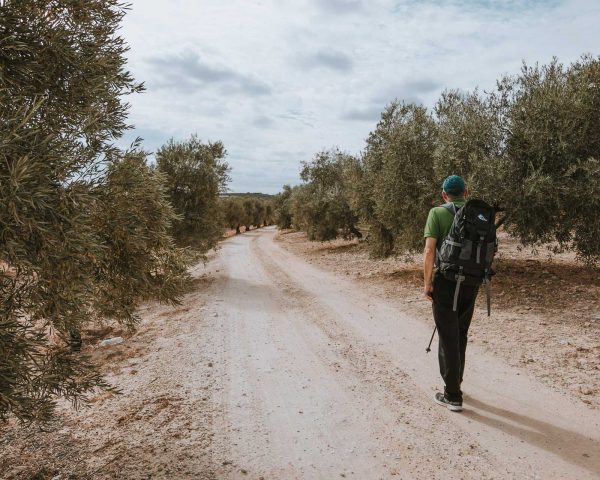
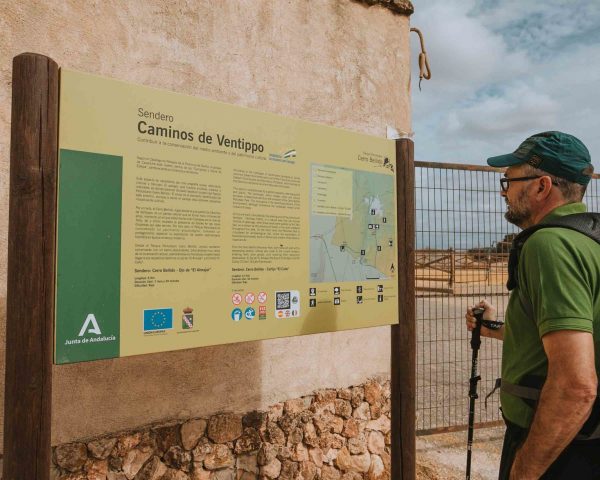
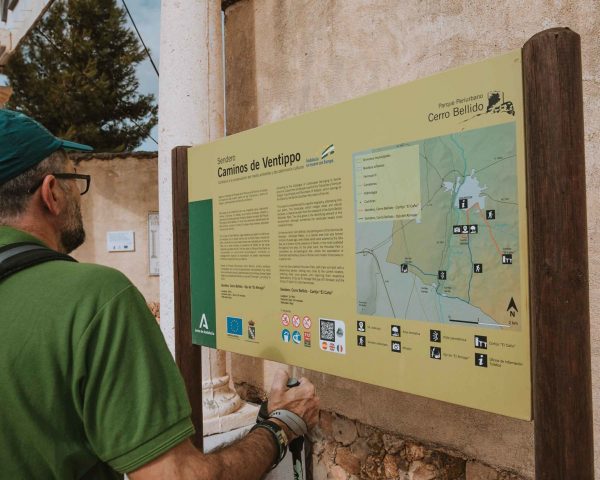
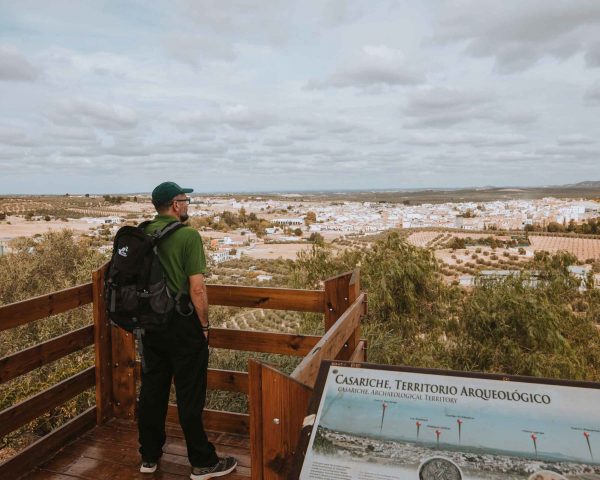
It is located to the south of Casariche, a landscape that is very representative of karst landscapes. This is a place where the water table of an aquifer reaches the surface, causing outcrops of water.
In the past, it was a very popular place for the inhabitants of Casariche, who used to go there to clean their clothes, taking advantage of the crystal-clear water and the cool, quiet and shady surroundings. Today, this spring is used by farmers to irrigate their crops, as well as by livestock farmers to quench the thirst of their livestock.
“El Almajar” is a place of incalculable value for the people of Casariche, both from a scenic, natural and historical point of view. After being a meeting place during the 19th and 20th centuries, it has become embedded in the culture of the municipality, being referred to on many occasions as an exponent of a longed-for past.
Cortijos are the most common agricultural constructions in the Andalusian countryside and the place where laborers, together with the owners of the hacienda, rested after long working days. These spaces were mainly linked to agriculture, although, on occasions, their economy was diversified thanks to livestock farming, an activity that provided advantages such as obtaining manure to improve crop production.
In Casariche, one of the best examples of this type of building is the Cortijo “El Caño”. It was built as a result of an ever-increasing number of farms, characterized by a system of crop rotation – generally rain-fed cereals and olive groves. Today, the remains that have been preserved bear witness to the dimensions of this estate.
| Cookie | Tipo | Duración | Descripción |
|---|---|---|---|
| cookielawinfo-casilla-funcional | 0 | 11 meses | La cookie está configurada por GDPR Cookie Consent para registrar el consentimiento del usuario para las cookies en la categoría "Funcional". |
| cookielawinfo-casilla-necesario | 0 | 11 meses | Esta cookie está configurada por el complemento GDPR Cookie Consent. Las cookies se utilizan para almacenar el consentimiento del usuario para las cookies en la categoría "Necesario". |
| cookielawinfo-casilla-otros | 0 | 11 meses | Esta cookie está configurada por el complemento de consentimiento de cookies de GDPR. La cookie se utiliza para almacenar el consentimiento del usuario para las cookies en la categoría "Otros. |
| cookielawinfo-casilla-rendimiento | 0 | 11 meses | Esta cookie está configurada por el complemento de consentimiento de cookies de GDPR. La cookie se utiliza para almacenar el consentimiento del usuario para las cookies en la categoría "Rendimiento". |
| cookielawinfo-checkbox-análisis | 0 | 11 meses | Esta cookie está configurada por el complemento de consentimiento de cookies de GDPR. La cookie se utiliza para almacenar el consentimiento del usuario para las cookies en la categoría "Análisis". |
| vista_política_cookies | 0 | 11 meses | La cookie está configurada por el complemento GDPR Cookie Consent y se utiliza para almacenar si el usuario ha dado su consentimiento o no para el uso de cookies. No almacena ningún dato personal. |
| Cookie | Tipo | Duración | Descripción |
|---|---|---|---|
| cookielawinfo-casilla-funcional | 0 | 11 meses | La cookie está configurada por GDPR Cookie Consent para registrar el consentimiento del usuario para las cookies en la categoría "Funcional". |
| cookielawinfo-casilla-necesario | 0 | 11 meses | Esta cookie está configurada por el complemento GDPR Cookie Consent. Las cookies se utilizan para almacenar el consentimiento del usuario para las cookies en la categoría "Necesario". |
| cookielawinfo-casilla-otros | 0 | 11 meses | Esta cookie está configurada por el complemento de consentimiento de cookies de GDPR. La cookie se utiliza para almacenar el consentimiento del usuario para las cookies en la categoría "Otros. |
| cookielawinfo-casilla-rendimiento | 0 | 11 meses | Esta cookie está configurada por el complemento de consentimiento de cookies de GDPR. La cookie se utiliza para almacenar el consentimiento del usuario para las cookies en la categoría "Rendimiento". |
| cookielawinfo-checkbox-análisis | 0 | 11 meses | Esta cookie está configurada por el complemento de consentimiento de cookies de GDPR. La cookie se utiliza para almacenar el consentimiento del usuario para las cookies en la categoría "Análisis". |
| vista_política_cookies | 0 | 11 meses | La cookie está configurada por el complemento GDPR Cookie Consent y se utiliza para almacenar si el usuario ha dado su consentimiento o no para el uso de cookies. No almacena ningún dato personal. |
| Cookie | Tipo | Duración | Descripción |
|---|---|---|---|
| cookielawinfo-casilla-funcional | 0 | 11 meses | La cookie está configurada por GDPR Cookie Consent para registrar el consentimiento del usuario para las cookies en la categoría "Funcional". |
| cookielawinfo-casilla-necesario | 0 | 11 meses | Esta cookie está configurada por el complemento GDPR Cookie Consent. Las cookies se utilizan para almacenar el consentimiento del usuario para las cookies en la categoría "Necesario". |
| cookielawinfo-casilla-otros | 0 | 11 meses | Esta cookie está configurada por el complemento de consentimiento de cookies de GDPR. La cookie se utiliza para almacenar el consentimiento del usuario para las cookies en la categoría "Otros. |
| cookielawinfo-casilla-rendimiento | 0 | 11 meses | Esta cookie está configurada por el complemento de consentimiento de cookies de GDPR. La cookie se utiliza para almacenar el consentimiento del usuario para las cookies en la categoría "Rendimiento". |
| cookielawinfo-checkbox-análisis | 0 | 11 meses | Esta cookie está configurada por el complemento de consentimiento de cookies de GDPR. La cookie se utiliza para almacenar el consentimiento del usuario para las cookies en la categoría "Análisis". |
| vista_política_cookies | 0 | 11 meses | La cookie está configurada por el complemento GDPR Cookie Consent y se utiliza para almacenar si el usuario ha dado su consentimiento o no para el uso de cookies. No almacena ningún dato personal. |
| Cookie | Tipo | Duración | Descripción |
|---|---|---|---|
| cookielawinfo-casilla-funcional | 0 | 11 meses | La cookie está configurada por GDPR Cookie Consent para registrar el consentimiento del usuario para las cookies en la categoría "Funcional". |
| cookielawinfo-casilla-necesario | 0 | 11 meses | Esta cookie está configurada por el complemento GDPR Cookie Consent. Las cookies se utilizan para almacenar el consentimiento del usuario para las cookies en la categoría "Necesario". |
| cookielawinfo-casilla-otros | 0 | 11 meses | Esta cookie está configurada por el complemento de consentimiento de cookies de GDPR. La cookie se utiliza para almacenar el consentimiento del usuario para las cookies en la categoría "Otros. |
| cookielawinfo-casilla-rendimiento | 0 | 11 meses | Esta cookie está configurada por el complemento de consentimiento de cookies de GDPR. La cookie se utiliza para almacenar el consentimiento del usuario para las cookies en la categoría "Rendimiento". |
| cookielawinfo-checkbox-análisis | 0 | 11 meses | Esta cookie está configurada por el complemento de consentimiento de cookies de GDPR. La cookie se utiliza para almacenar el consentimiento del usuario para las cookies en la categoría "Análisis". |
| vista_política_cookies | 0 | 11 meses | La cookie está configurada por el complemento GDPR Cookie Consent y se utiliza para almacenar si el usuario ha dado su consentimiento o no para el uso de cookies. No almacena ningún dato personal. |
| Cookie | Tipo | Duración | Descripción |
|---|---|---|---|
| cookielawinfo-casilla-funcional | 0 | 11 meses | La cookie está configurada por GDPR Cookie Consent para registrar el consentimiento del usuario para las cookies en la categoría "Funcional". |
| cookielawinfo-casilla-necesario | 0 | 11 meses | Esta cookie está configurada por el complemento GDPR Cookie Consent. Las cookies se utilizan para almacenar el consentimiento del usuario para las cookies en la categoría "Necesario". |
| cookielawinfo-casilla-otros | 0 | 11 meses | Esta cookie está configurada por el complemento de consentimiento de cookies de GDPR. La cookie se utiliza para almacenar el consentimiento del usuario para las cookies en la categoría "Otros. |
| cookielawinfo-casilla-rendimiento | 0 | 11 meses | Esta cookie está configurada por el complemento de consentimiento de cookies de GDPR. La cookie se utiliza para almacenar el consentimiento del usuario para las cookies en la categoría "Rendimiento". |
| cookielawinfo-checkbox-análisis | 0 | 11 meses | Esta cookie está configurada por el complemento de consentimiento de cookies de GDPR. La cookie se utiliza para almacenar el consentimiento del usuario para las cookies en la categoría "Análisis". |
| vista_política_cookies | 0 | 11 meses | La cookie está configurada por el complemento GDPR Cookie Consent y se utiliza para almacenar si el usuario ha dado su consentimiento o no para el uso de cookies. No almacena ningún dato personal. |
| Cookie | Tipo | Duración | Descripción |
|---|---|---|---|
| cookielawinfo-casilla-funcional | 0 | 11 meses | La cookie está configurada por GDPR Cookie Consent para registrar el consentimiento del usuario para las cookies en la categoría "Funcional". |
| cookielawinfo-casilla-necesario | 0 | 11 meses | Esta cookie está configurada por el complemento GDPR Cookie Consent. Las cookies se utilizan para almacenar el consentimiento del usuario para las cookies en la categoría "Necesario". |
| cookielawinfo-casilla-otros | 0 | 11 meses | Esta cookie está configurada por el complemento de consentimiento de cookies de GDPR. La cookie se utiliza para almacenar el consentimiento del usuario para las cookies en la categoría "Otros. |
| cookielawinfo-casilla-rendimiento | 0 | 11 meses | Esta cookie está configurada por el complemento de consentimiento de cookies de GDPR. La cookie se utiliza para almacenar el consentimiento del usuario para las cookies en la categoría "Rendimiento". |
| cookielawinfo-checkbox-análisis | 0 | 11 meses | Esta cookie está configurada por el complemento de consentimiento de cookies de GDPR. La cookie se utiliza para almacenar el consentimiento del usuario para las cookies en la categoría "Análisis". |
| vista_política_cookies | 0 | 11 meses | La cookie está configurada por el complemento GDPR Cookie Consent y se utiliza para almacenar si el usuario ha dado su consentimiento o no para el uso de cookies. No almacena ningún dato personal. |